Management Accounting Report: Neptune International Ltd Analysis
VerifiedAdded on 2023/01/19
|11
|2357
|94
Report
AI Summary
This management accounting report, prepared for Neptune International Ltd, a diversified manufacturing company, analyzes various aspects of financial management. It begins with an examination of manufacturing cost flows and cost behavior, including production capacity and its constraints. The report then constructs a comprehensive manufacturing budget and evaluates strategic management reports, particularly focusing on the potential for expanding production capacity and the financial implications of such expansion. Furthermore, it delves into strategic and international issues, considering the growth opportunities in the Chinese market, the importance of Guanxi in Chinese business practices, and the challenges of integrating Western accounting methods. The report also includes comparative analyses of revenue and cost structures, and offers recommendations based on the financial data provided, assessing the impact of strategic decisions on profitability and return on total assets (ROTA). The assignment provides detailed financial analysis and strategic insights for Neptune International Ltd.
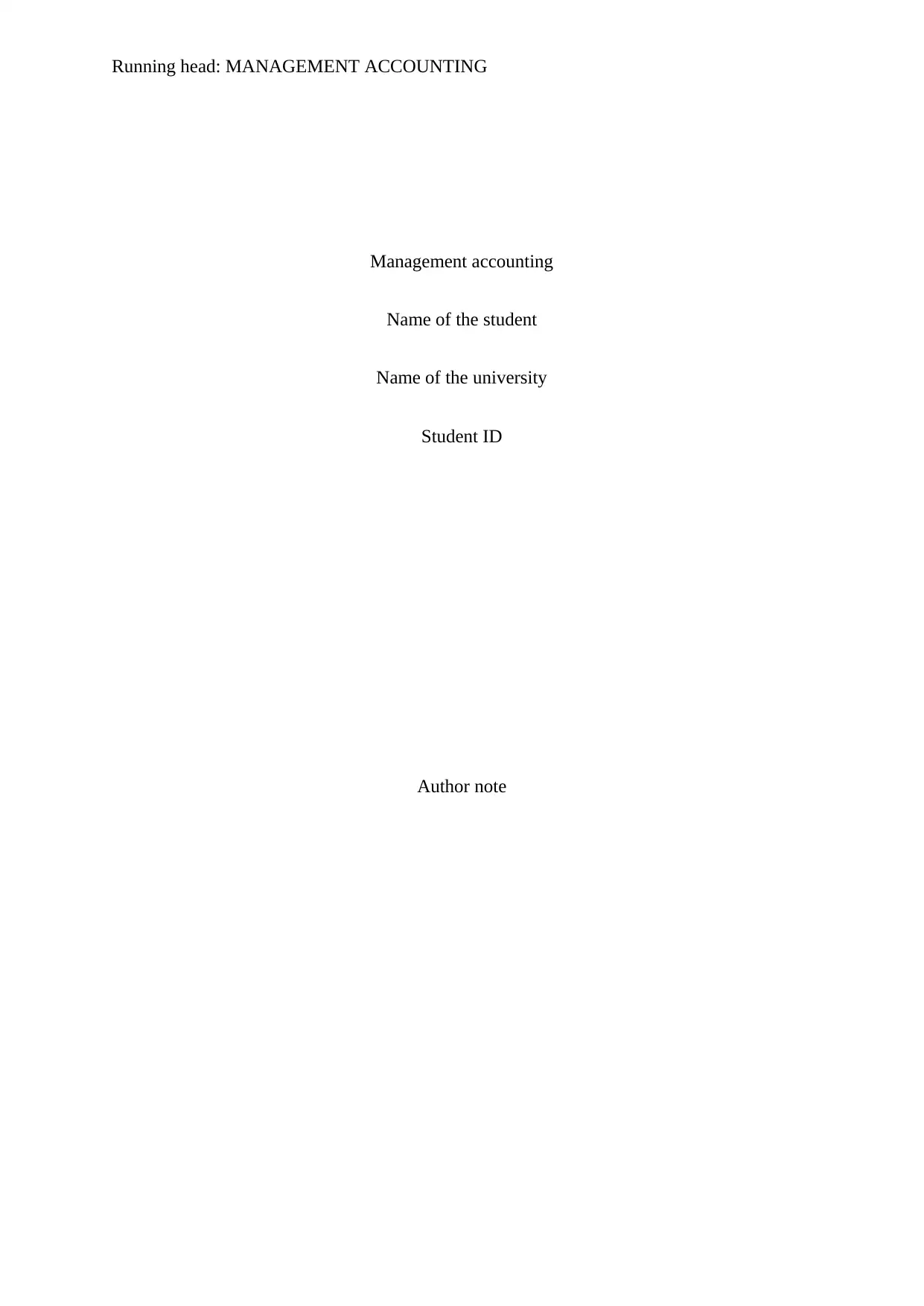
Running head: MANAGEMENT ACCOUNTING
Management accounting
Name of the student
Name of the university
Student ID
Author note
Management accounting
Name of the student
Name of the university
Student ID
Author note
Paraphrase This Document
Need a fresh take? Get an instant paraphrase of this document with our AI Paraphraser
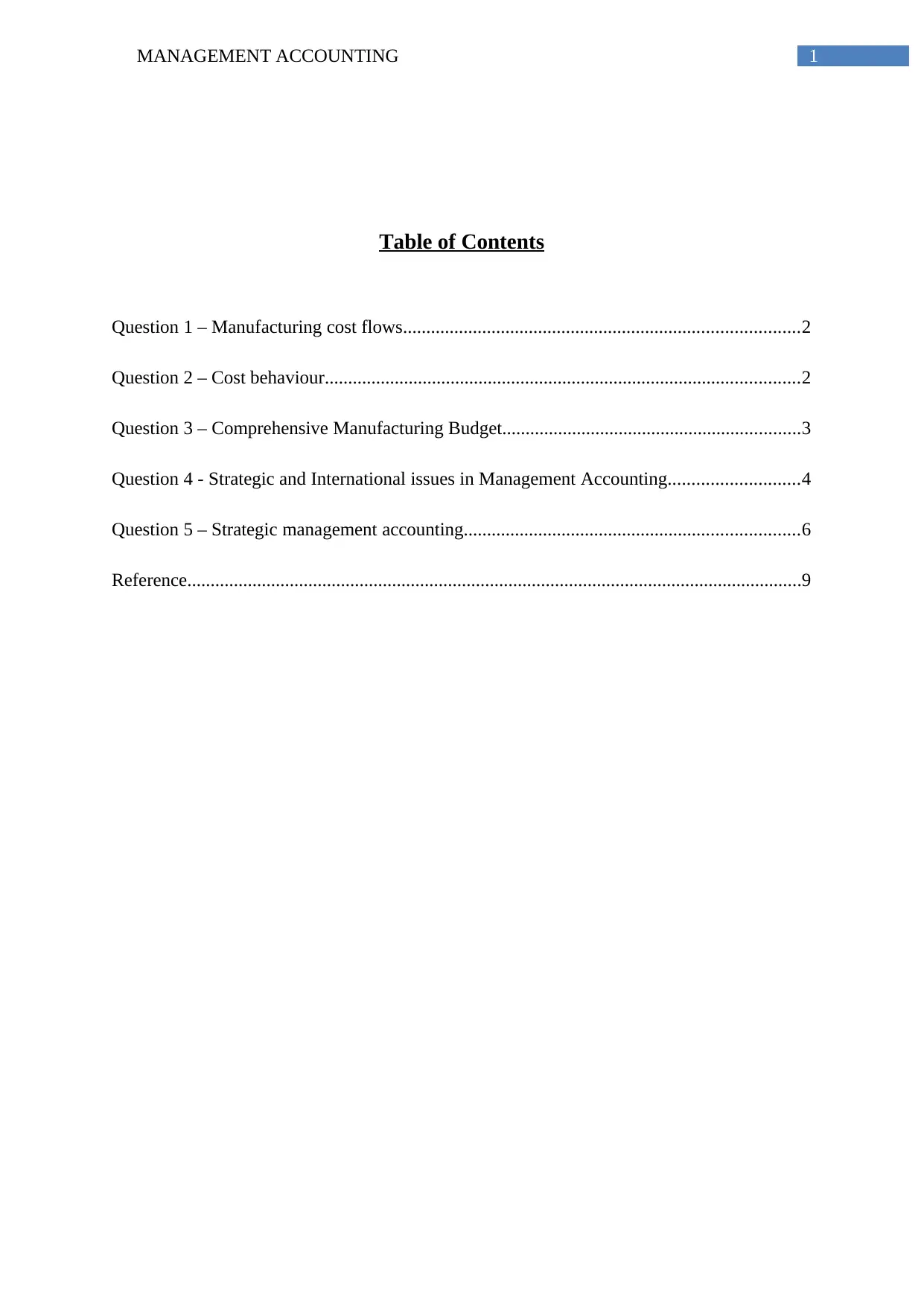
1MANAGEMENT ACCOUNTING
Table of Contents
Question 1 – Manufacturing cost flows.....................................................................................2
Question 2 – Cost behaviour......................................................................................................2
Question 3 – Comprehensive Manufacturing Budget................................................................3
Question 4 - Strategic and International issues in Management Accounting............................4
Question 5 – Strategic management accounting........................................................................6
Reference....................................................................................................................................9
Table of Contents
Question 1 – Manufacturing cost flows.....................................................................................2
Question 2 – Cost behaviour......................................................................................................2
Question 3 – Comprehensive Manufacturing Budget................................................................3
Question 4 - Strategic and International issues in Management Accounting............................4
Question 5 – Strategic management accounting........................................................................6
Reference....................................................................................................................................9
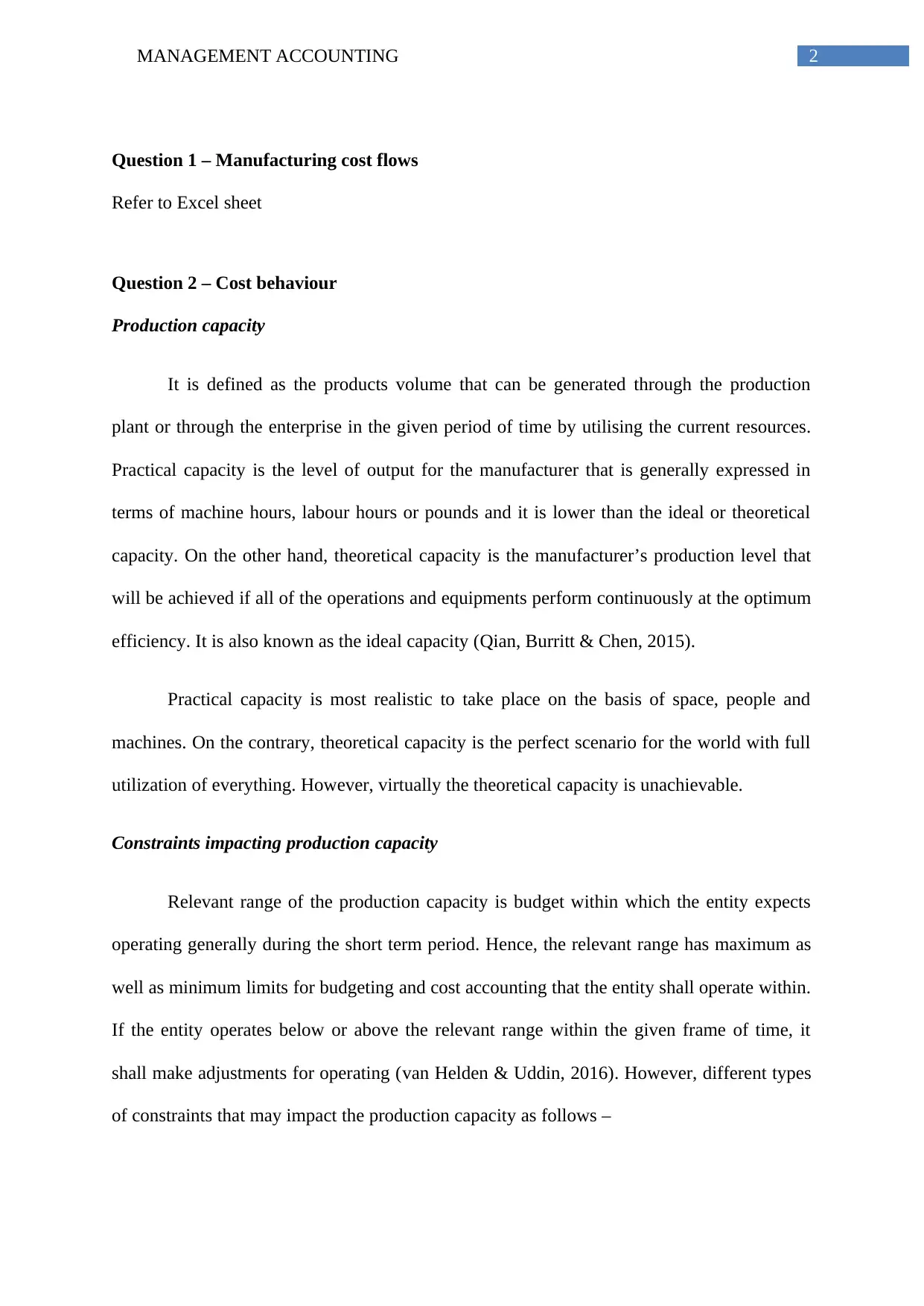
2MANAGEMENT ACCOUNTING
Question 1 – Manufacturing cost flows
Refer to Excel sheet
Question 2 – Cost behaviour
Production capacity
It is defined as the products volume that can be generated through the production
plant or through the enterprise in the given period of time by utilising the current resources.
Practical capacity is the level of output for the manufacturer that is generally expressed in
terms of machine hours, labour hours or pounds and it is lower than the ideal or theoretical
capacity. On the other hand, theoretical capacity is the manufacturer’s production level that
will be achieved if all of the operations and equipments perform continuously at the optimum
efficiency. It is also known as the ideal capacity (Qian, Burritt & Chen, 2015).
Practical capacity is most realistic to take place on the basis of space, people and
machines. On the contrary, theoretical capacity is the perfect scenario for the world with full
utilization of everything. However, virtually the theoretical capacity is unachievable.
Constraints impacting production capacity
Relevant range of the production capacity is budget within which the entity expects
operating generally during the short term period. Hence, the relevant range has maximum as
well as minimum limits for budgeting and cost accounting that the entity shall operate within.
If the entity operates below or above the relevant range within the given frame of time, it
shall make adjustments for operating (van Helden & Uddin, 2016). However, different types
of constraints that may impact the production capacity as follows –
Question 1 – Manufacturing cost flows
Refer to Excel sheet
Question 2 – Cost behaviour
Production capacity
It is defined as the products volume that can be generated through the production
plant or through the enterprise in the given period of time by utilising the current resources.
Practical capacity is the level of output for the manufacturer that is generally expressed in
terms of machine hours, labour hours or pounds and it is lower than the ideal or theoretical
capacity. On the other hand, theoretical capacity is the manufacturer’s production level that
will be achieved if all of the operations and equipments perform continuously at the optimum
efficiency. It is also known as the ideal capacity (Qian, Burritt & Chen, 2015).
Practical capacity is most realistic to take place on the basis of space, people and
machines. On the contrary, theoretical capacity is the perfect scenario for the world with full
utilization of everything. However, virtually the theoretical capacity is unachievable.
Constraints impacting production capacity
Relevant range of the production capacity is budget within which the entity expects
operating generally during the short term period. Hence, the relevant range has maximum as
well as minimum limits for budgeting and cost accounting that the entity shall operate within.
If the entity operates below or above the relevant range within the given frame of time, it
shall make adjustments for operating (van Helden & Uddin, 2016). However, different types
of constraints that may impact the production capacity as follows –
⊘ This is a preview!⊘
Do you want full access?
Subscribe today to unlock all pages.

Trusted by 1+ million students worldwide
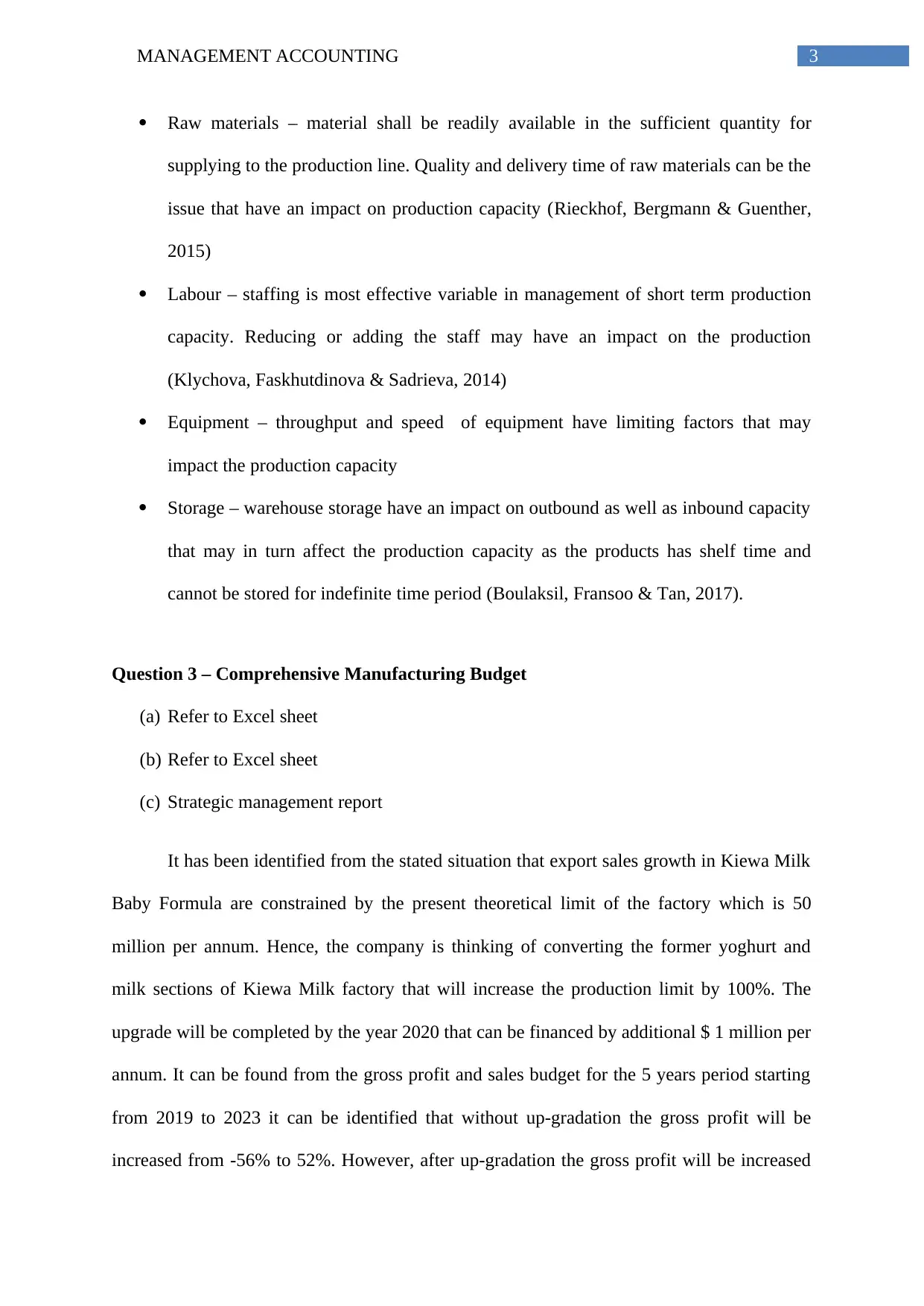
3MANAGEMENT ACCOUNTING
Raw materials – material shall be readily available in the sufficient quantity for
supplying to the production line. Quality and delivery time of raw materials can be the
issue that have an impact on production capacity (Rieckhof, Bergmann & Guenther,
2015)
Labour – staffing is most effective variable in management of short term production
capacity. Reducing or adding the staff may have an impact on the production
(Klychova, Faskhutdinova & Sadrieva, 2014)
Equipment – throughput and speed of equipment have limiting factors that may
impact the production capacity
Storage – warehouse storage have an impact on outbound as well as inbound capacity
that may in turn affect the production capacity as the products has shelf time and
cannot be stored for indefinite time period (Boulaksil, Fransoo & Tan, 2017).
Question 3 – Comprehensive Manufacturing Budget
(a) Refer to Excel sheet
(b) Refer to Excel sheet
(c) Strategic management report
It has been identified from the stated situation that export sales growth in Kiewa Milk
Baby Formula are constrained by the present theoretical limit of the factory which is 50
million per annum. Hence, the company is thinking of converting the former yoghurt and
milk sections of Kiewa Milk factory that will increase the production limit by 100%. The
upgrade will be completed by the year 2020 that can be financed by additional $ 1 million per
annum. It can be found from the gross profit and sales budget for the 5 years period starting
from 2019 to 2023 it can be identified that without up-gradation the gross profit will be
increased from -56% to 52%. However, after up-gradation the gross profit will be increased
Raw materials – material shall be readily available in the sufficient quantity for
supplying to the production line. Quality and delivery time of raw materials can be the
issue that have an impact on production capacity (Rieckhof, Bergmann & Guenther,
2015)
Labour – staffing is most effective variable in management of short term production
capacity. Reducing or adding the staff may have an impact on the production
(Klychova, Faskhutdinova & Sadrieva, 2014)
Equipment – throughput and speed of equipment have limiting factors that may
impact the production capacity
Storage – warehouse storage have an impact on outbound as well as inbound capacity
that may in turn affect the production capacity as the products has shelf time and
cannot be stored for indefinite time period (Boulaksil, Fransoo & Tan, 2017).
Question 3 – Comprehensive Manufacturing Budget
(a) Refer to Excel sheet
(b) Refer to Excel sheet
(c) Strategic management report
It has been identified from the stated situation that export sales growth in Kiewa Milk
Baby Formula are constrained by the present theoretical limit of the factory which is 50
million per annum. Hence, the company is thinking of converting the former yoghurt and
milk sections of Kiewa Milk factory that will increase the production limit by 100%. The
upgrade will be completed by the year 2020 that can be financed by additional $ 1 million per
annum. It can be found from the gross profit and sales budget for the 5 years period starting
from 2019 to 2023 it can be identified that without up-gradation the gross profit will be
increased from -56% to 52%. However, after up-gradation the gross profit will be increased
Paraphrase This Document
Need a fresh take? Get an instant paraphrase of this document with our AI Paraphraser

4MANAGEMENT ACCOUNTING
from 56% to 68% over the years from 2019 to 2023. Further, it is found that rates of gross
profit margin are significantly high after up-gradation. Further, it can be stated that without
up-gradation the entity will face the production limit constraint. Hence, even if the entity gets
the opportunity of selling more units owing to production limit constraint it will not have
sufficient number of units to be sold. Hence, it is suggested that the entity shall ignore the
short term benefits and taking into consideration the long term benefits up-gradation shall be
made to the product line for overcoming the production constraint (Jamil et al., 2015).
Question 4 - Strategic and International issues in Management Accounting
Part 1
As urbanisation is rapidly growing in China and number of middle class people are
increasing the demand of the consumers for the high quality of the dairy products are
expected to be increased in the next ten years. Further, the sales channels are changing
rapidly in context of pricing, regulation for new entry like cross border e-commerce.
However, the leading Australian dairy firms are exploring the opportunities for growth and
collaboration in rapidly expanding dairy market of China. Further, the recent closure of
Murray Goulburn which left number of people jobless in Kiewa valley will provide an
opportunity for Neptune International in the same place. Based on the projected sales and
profit it can be seen that proposed purchase of can be printable (Otley, 2016). However the
inherent risks are as follows –
Expected sales and profits are just the budget and prepared on the basis of
assumption. In actual the scenario may be different and the sales and profit can be
much lower as compared to the expectation.
Due to unfavourable situation in market that may arise in any time, the Australian
dollar value may fall against the Chinese Yuan that will have adverse impact on the
from 56% to 68% over the years from 2019 to 2023. Further, it is found that rates of gross
profit margin are significantly high after up-gradation. Further, it can be stated that without
up-gradation the entity will face the production limit constraint. Hence, even if the entity gets
the opportunity of selling more units owing to production limit constraint it will not have
sufficient number of units to be sold. Hence, it is suggested that the entity shall ignore the
short term benefits and taking into consideration the long term benefits up-gradation shall be
made to the product line for overcoming the production constraint (Jamil et al., 2015).
Question 4 - Strategic and International issues in Management Accounting
Part 1
As urbanisation is rapidly growing in China and number of middle class people are
increasing the demand of the consumers for the high quality of the dairy products are
expected to be increased in the next ten years. Further, the sales channels are changing
rapidly in context of pricing, regulation for new entry like cross border e-commerce.
However, the leading Australian dairy firms are exploring the opportunities for growth and
collaboration in rapidly expanding dairy market of China. Further, the recent closure of
Murray Goulburn which left number of people jobless in Kiewa valley will provide an
opportunity for Neptune International in the same place. Based on the projected sales and
profit it can be seen that proposed purchase of can be printable (Otley, 2016). However the
inherent risks are as follows –
Expected sales and profits are just the budget and prepared on the basis of
assumption. In actual the scenario may be different and the sales and profit can be
much lower as compared to the expectation.
Due to unfavourable situation in market that may arise in any time, the Australian
dollar value may fall against the Chinese Yuan that will have adverse impact on the
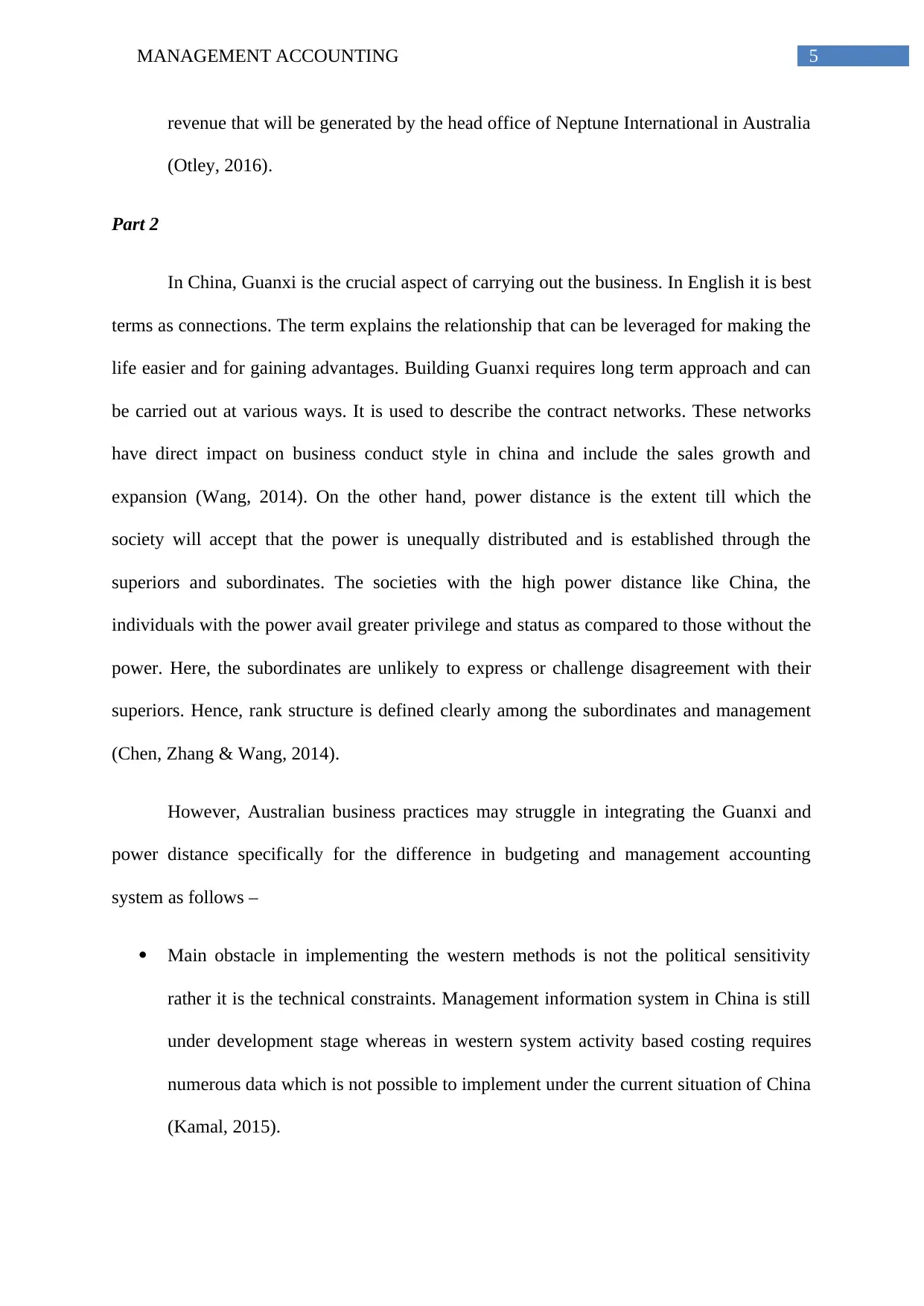
5MANAGEMENT ACCOUNTING
revenue that will be generated by the head office of Neptune International in Australia
(Otley, 2016).
Part 2
In China, Guanxi is the crucial aspect of carrying out the business. In English it is best
terms as connections. The term explains the relationship that can be leveraged for making the
life easier and for gaining advantages. Building Guanxi requires long term approach and can
be carried out at various ways. It is used to describe the contract networks. These networks
have direct impact on business conduct style in china and include the sales growth and
expansion (Wang, 2014). On the other hand, power distance is the extent till which the
society will accept that the power is unequally distributed and is established through the
superiors and subordinates. The societies with the high power distance like China, the
individuals with the power avail greater privilege and status as compared to those without the
power. Here, the subordinates are unlikely to express or challenge disagreement with their
superiors. Hence, rank structure is defined clearly among the subordinates and management
(Chen, Zhang & Wang, 2014).
However, Australian business practices may struggle in integrating the Guanxi and
power distance specifically for the difference in budgeting and management accounting
system as follows –
Main obstacle in implementing the western methods is not the political sensitivity
rather it is the technical constraints. Management information system in China is still
under development stage whereas in western system activity based costing requires
numerous data which is not possible to implement under the current situation of China
(Kamal, 2015).
revenue that will be generated by the head office of Neptune International in Australia
(Otley, 2016).
Part 2
In China, Guanxi is the crucial aspect of carrying out the business. In English it is best
terms as connections. The term explains the relationship that can be leveraged for making the
life easier and for gaining advantages. Building Guanxi requires long term approach and can
be carried out at various ways. It is used to describe the contract networks. These networks
have direct impact on business conduct style in china and include the sales growth and
expansion (Wang, 2014). On the other hand, power distance is the extent till which the
society will accept that the power is unequally distributed and is established through the
superiors and subordinates. The societies with the high power distance like China, the
individuals with the power avail greater privilege and status as compared to those without the
power. Here, the subordinates are unlikely to express or challenge disagreement with their
superiors. Hence, rank structure is defined clearly among the subordinates and management
(Chen, Zhang & Wang, 2014).
However, Australian business practices may struggle in integrating the Guanxi and
power distance specifically for the difference in budgeting and management accounting
system as follows –
Main obstacle in implementing the western methods is not the political sensitivity
rather it is the technical constraints. Management information system in China is still
under development stage whereas in western system activity based costing requires
numerous data which is not possible to implement under the current situation of China
(Kamal, 2015).
⊘ This is a preview!⊘
Do you want full access?
Subscribe today to unlock all pages.

Trusted by 1+ million students worldwide
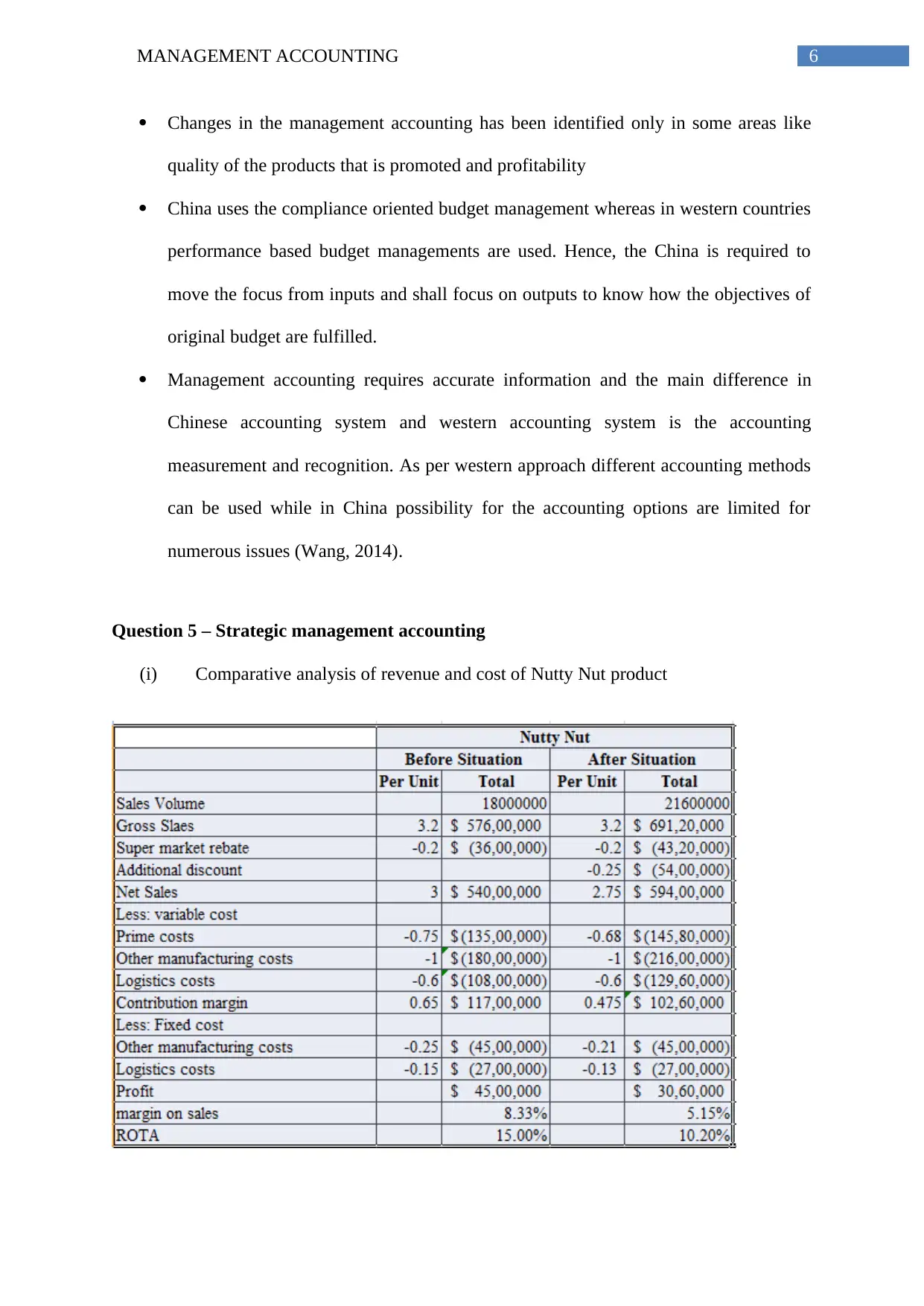
6MANAGEMENT ACCOUNTING
Changes in the management accounting has been identified only in some areas like
quality of the products that is promoted and profitability
China uses the compliance oriented budget management whereas in western countries
performance based budget managements are used. Hence, the China is required to
move the focus from inputs and shall focus on outputs to know how the objectives of
original budget are fulfilled.
Management accounting requires accurate information and the main difference in
Chinese accounting system and western accounting system is the accounting
measurement and recognition. As per western approach different accounting methods
can be used while in China possibility for the accounting options are limited for
numerous issues (Wang, 2014).
Question 5 – Strategic management accounting
(i) Comparative analysis of revenue and cost of Nutty Nut product
Changes in the management accounting has been identified only in some areas like
quality of the products that is promoted and profitability
China uses the compliance oriented budget management whereas in western countries
performance based budget managements are used. Hence, the China is required to
move the focus from inputs and shall focus on outputs to know how the objectives of
original budget are fulfilled.
Management accounting requires accurate information and the main difference in
Chinese accounting system and western accounting system is the accounting
measurement and recognition. As per western approach different accounting methods
can be used while in China possibility for the accounting options are limited for
numerous issues (Wang, 2014).
Question 5 – Strategic management accounting
(i) Comparative analysis of revenue and cost of Nutty Nut product
Paraphrase This Document
Need a fresh take? Get an instant paraphrase of this document with our AI Paraphraser
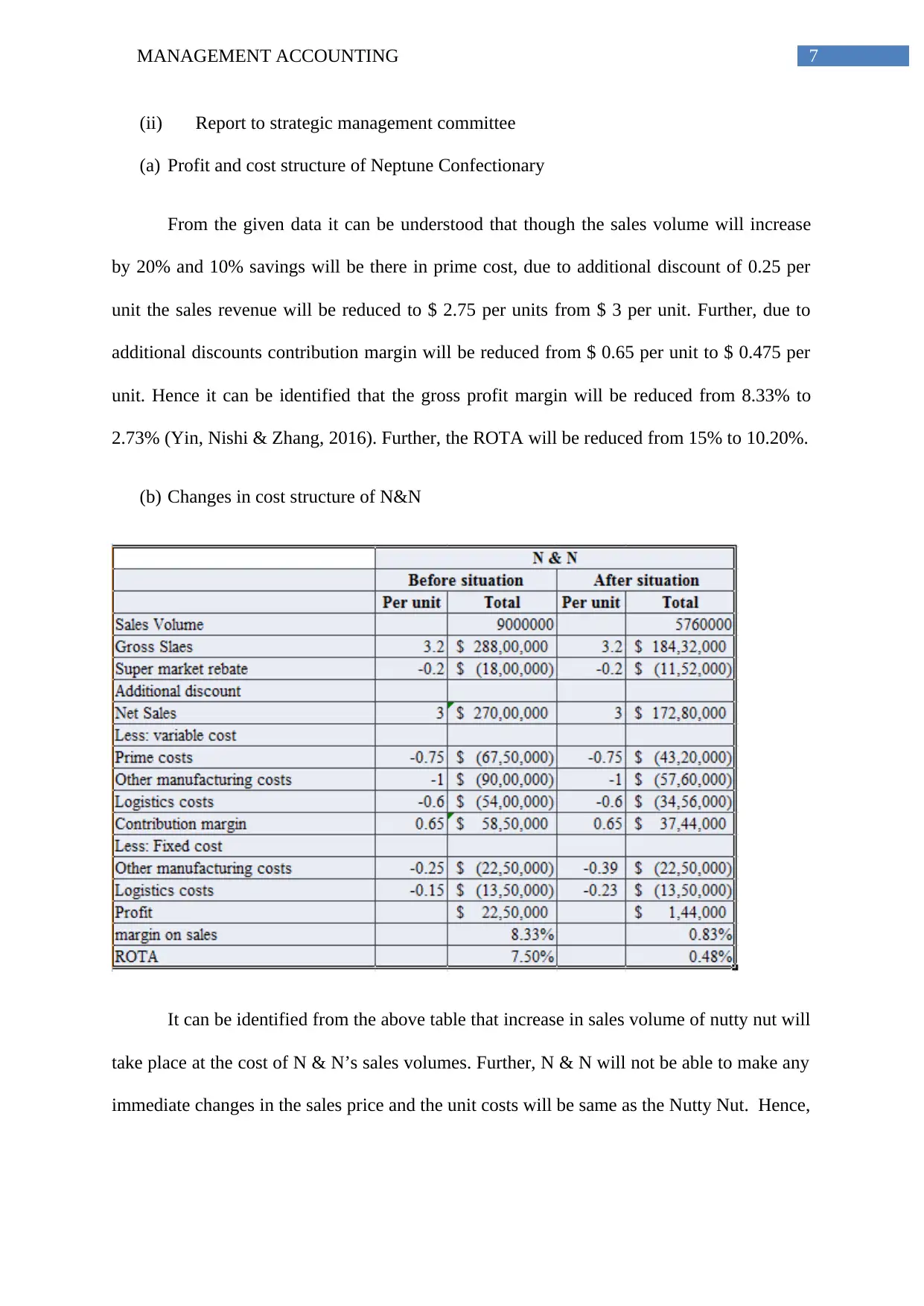
7MANAGEMENT ACCOUNTING
(ii) Report to strategic management committee
(a) Profit and cost structure of Neptune Confectionary
From the given data it can be understood that though the sales volume will increase
by 20% and 10% savings will be there in prime cost, due to additional discount of 0.25 per
unit the sales revenue will be reduced to $ 2.75 per units from $ 3 per unit. Further, due to
additional discounts contribution margin will be reduced from $ 0.65 per unit to $ 0.475 per
unit. Hence it can be identified that the gross profit margin will be reduced from 8.33% to
2.73% (Yin, Nishi & Zhang, 2016). Further, the ROTA will be reduced from 15% to 10.20%.
(b) Changes in cost structure of N&N
It can be identified from the above table that increase in sales volume of nutty nut will
take place at the cost of N & N’s sales volumes. Further, N & N will not be able to make any
immediate changes in the sales price and the unit costs will be same as the Nutty Nut. Hence,
(ii) Report to strategic management committee
(a) Profit and cost structure of Neptune Confectionary
From the given data it can be understood that though the sales volume will increase
by 20% and 10% savings will be there in prime cost, due to additional discount of 0.25 per
unit the sales revenue will be reduced to $ 2.75 per units from $ 3 per unit. Further, due to
additional discounts contribution margin will be reduced from $ 0.65 per unit to $ 0.475 per
unit. Hence it can be identified that the gross profit margin will be reduced from 8.33% to
2.73% (Yin, Nishi & Zhang, 2016). Further, the ROTA will be reduced from 15% to 10.20%.
(b) Changes in cost structure of N&N
It can be identified from the above table that increase in sales volume of nutty nut will
take place at the cost of N & N’s sales volumes. Further, N & N will not be able to make any
immediate changes in the sales price and the unit costs will be same as the Nutty Nut. Hence,
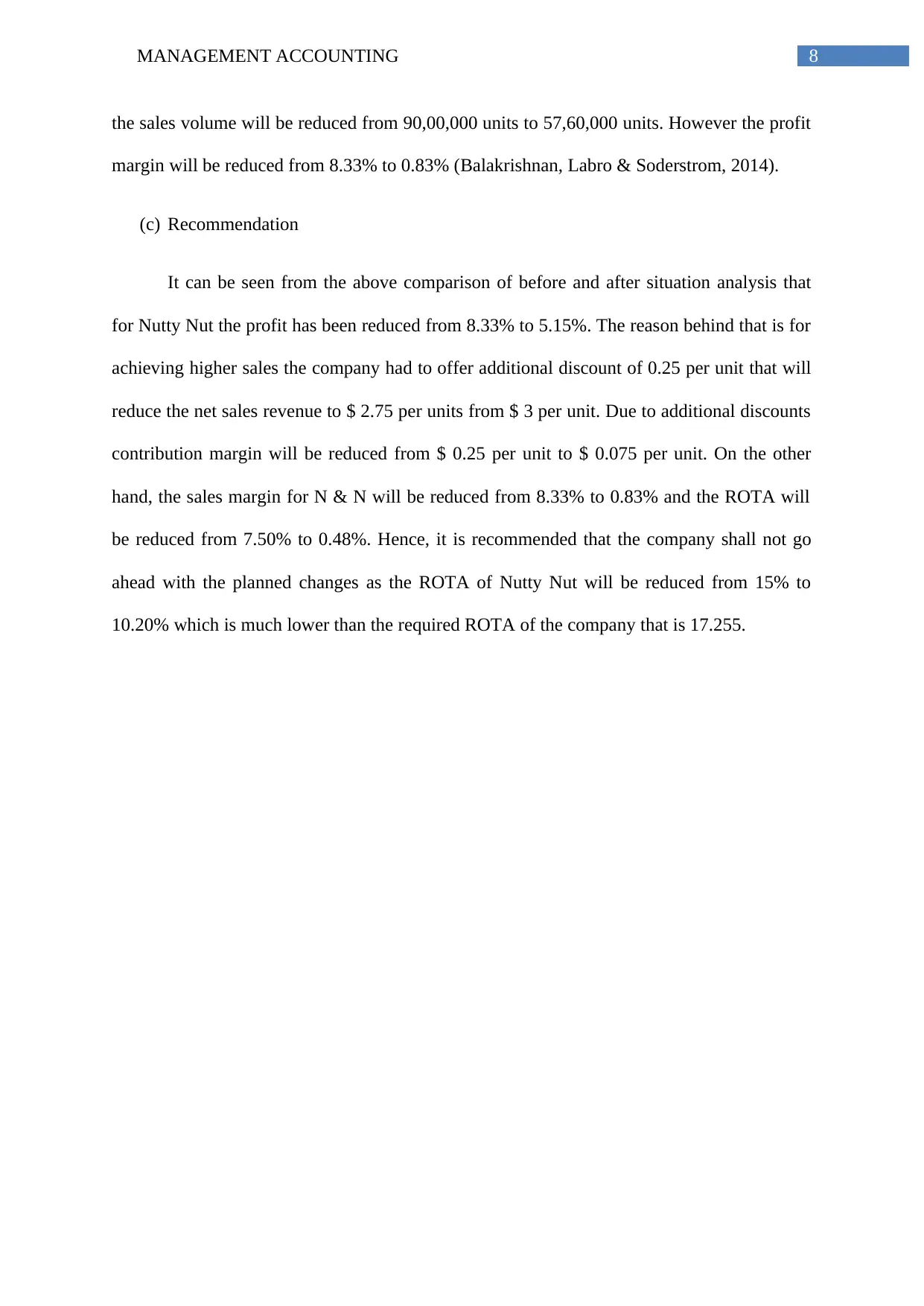
8MANAGEMENT ACCOUNTING
the sales volume will be reduced from 90,00,000 units to 57,60,000 units. However the profit
margin will be reduced from 8.33% to 0.83% (Balakrishnan, Labro & Soderstrom, 2014).
(c) Recommendation
It can be seen from the above comparison of before and after situation analysis that
for Nutty Nut the profit has been reduced from 8.33% to 5.15%. The reason behind that is for
achieving higher sales the company had to offer additional discount of 0.25 per unit that will
reduce the net sales revenue to $ 2.75 per units from $ 3 per unit. Due to additional discounts
contribution margin will be reduced from $ 0.25 per unit to $ 0.075 per unit. On the other
hand, the sales margin for N & N will be reduced from 8.33% to 0.83% and the ROTA will
be reduced from 7.50% to 0.48%. Hence, it is recommended that the company shall not go
ahead with the planned changes as the ROTA of Nutty Nut will be reduced from 15% to
10.20% which is much lower than the required ROTA of the company that is 17.255.
the sales volume will be reduced from 90,00,000 units to 57,60,000 units. However the profit
margin will be reduced from 8.33% to 0.83% (Balakrishnan, Labro & Soderstrom, 2014).
(c) Recommendation
It can be seen from the above comparison of before and after situation analysis that
for Nutty Nut the profit has been reduced from 8.33% to 5.15%. The reason behind that is for
achieving higher sales the company had to offer additional discount of 0.25 per unit that will
reduce the net sales revenue to $ 2.75 per units from $ 3 per unit. Due to additional discounts
contribution margin will be reduced from $ 0.25 per unit to $ 0.075 per unit. On the other
hand, the sales margin for N & N will be reduced from 8.33% to 0.83% and the ROTA will
be reduced from 7.50% to 0.48%. Hence, it is recommended that the company shall not go
ahead with the planned changes as the ROTA of Nutty Nut will be reduced from 15% to
10.20% which is much lower than the required ROTA of the company that is 17.255.
⊘ This is a preview!⊘
Do you want full access?
Subscribe today to unlock all pages.

Trusted by 1+ million students worldwide
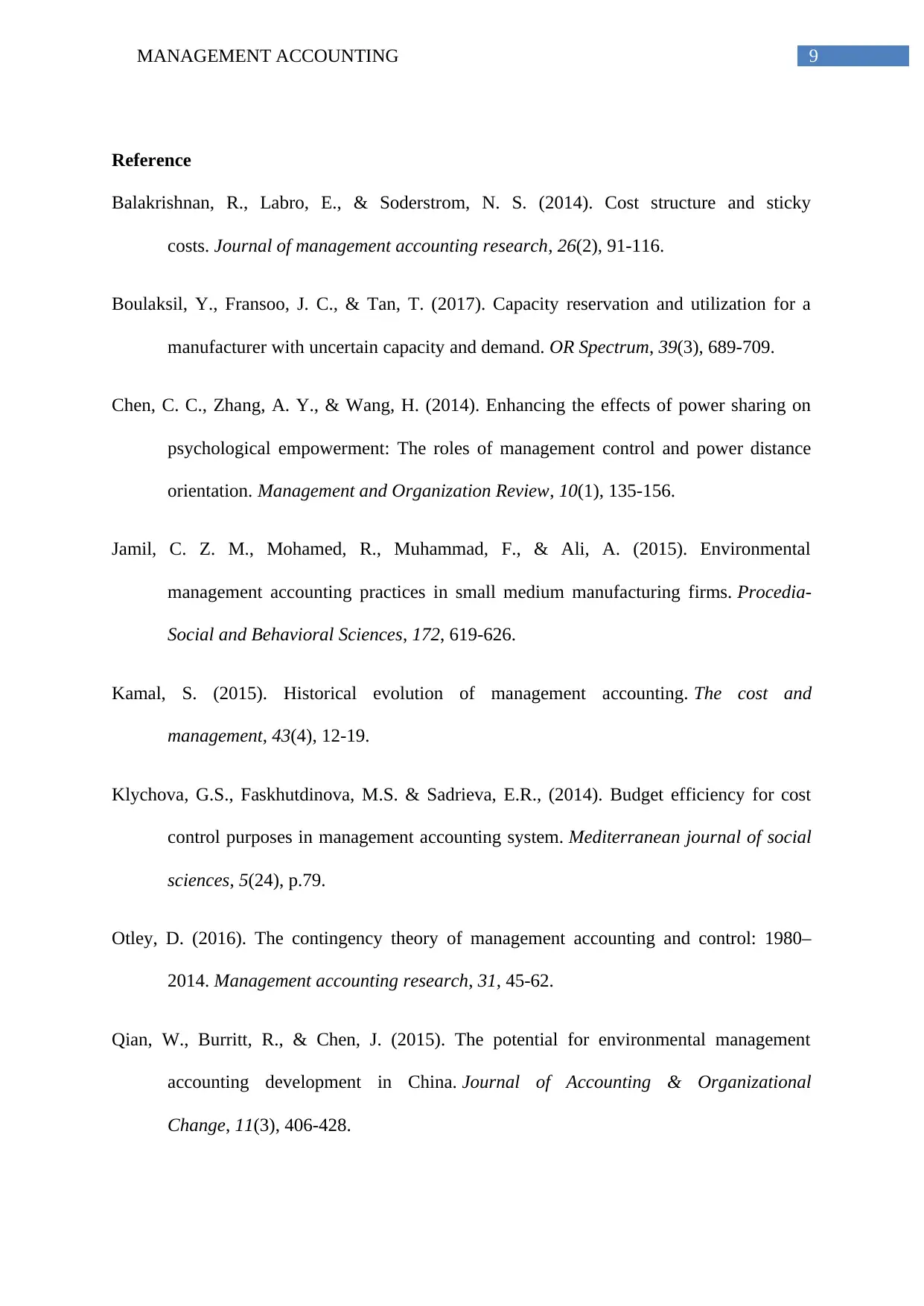
9MANAGEMENT ACCOUNTING
Reference
Balakrishnan, R., Labro, E., & Soderstrom, N. S. (2014). Cost structure and sticky
costs. Journal of management accounting research, 26(2), 91-116.
Boulaksil, Y., Fransoo, J. C., & Tan, T. (2017). Capacity reservation and utilization for a
manufacturer with uncertain capacity and demand. OR Spectrum, 39(3), 689-709.
Chen, C. C., Zhang, A. Y., & Wang, H. (2014). Enhancing the effects of power sharing on
psychological empowerment: The roles of management control and power distance
orientation. Management and Organization Review, 10(1), 135-156.
Jamil, C. Z. M., Mohamed, R., Muhammad, F., & Ali, A. (2015). Environmental
management accounting practices in small medium manufacturing firms. Procedia-
Social and Behavioral Sciences, 172, 619-626.
Kamal, S. (2015). Historical evolution of management accounting. The cost and
management, 43(4), 12-19.
Klychova, G.S., Faskhutdinova, М.S. & Sadrieva, E.R., (2014). Budget efficiency for cost
control purposes in management accounting system. Mediterranean journal of social
sciences, 5(24), p.79.
Otley, D. (2016). The contingency theory of management accounting and control: 1980–
2014. Management accounting research, 31, 45-62.
Qian, W., Burritt, R., & Chen, J. (2015). The potential for environmental management
accounting development in China. Journal of Accounting & Organizational
Change, 11(3), 406-428.
Reference
Balakrishnan, R., Labro, E., & Soderstrom, N. S. (2014). Cost structure and sticky
costs. Journal of management accounting research, 26(2), 91-116.
Boulaksil, Y., Fransoo, J. C., & Tan, T. (2017). Capacity reservation and utilization for a
manufacturer with uncertain capacity and demand. OR Spectrum, 39(3), 689-709.
Chen, C. C., Zhang, A. Y., & Wang, H. (2014). Enhancing the effects of power sharing on
psychological empowerment: The roles of management control and power distance
orientation. Management and Organization Review, 10(1), 135-156.
Jamil, C. Z. M., Mohamed, R., Muhammad, F., & Ali, A. (2015). Environmental
management accounting practices in small medium manufacturing firms. Procedia-
Social and Behavioral Sciences, 172, 619-626.
Kamal, S. (2015). Historical evolution of management accounting. The cost and
management, 43(4), 12-19.
Klychova, G.S., Faskhutdinova, М.S. & Sadrieva, E.R., (2014). Budget efficiency for cost
control purposes in management accounting system. Mediterranean journal of social
sciences, 5(24), p.79.
Otley, D. (2016). The contingency theory of management accounting and control: 1980–
2014. Management accounting research, 31, 45-62.
Qian, W., Burritt, R., & Chen, J. (2015). The potential for environmental management
accounting development in China. Journal of Accounting & Organizational
Change, 11(3), 406-428.
Paraphrase This Document
Need a fresh take? Get an instant paraphrase of this document with our AI Paraphraser
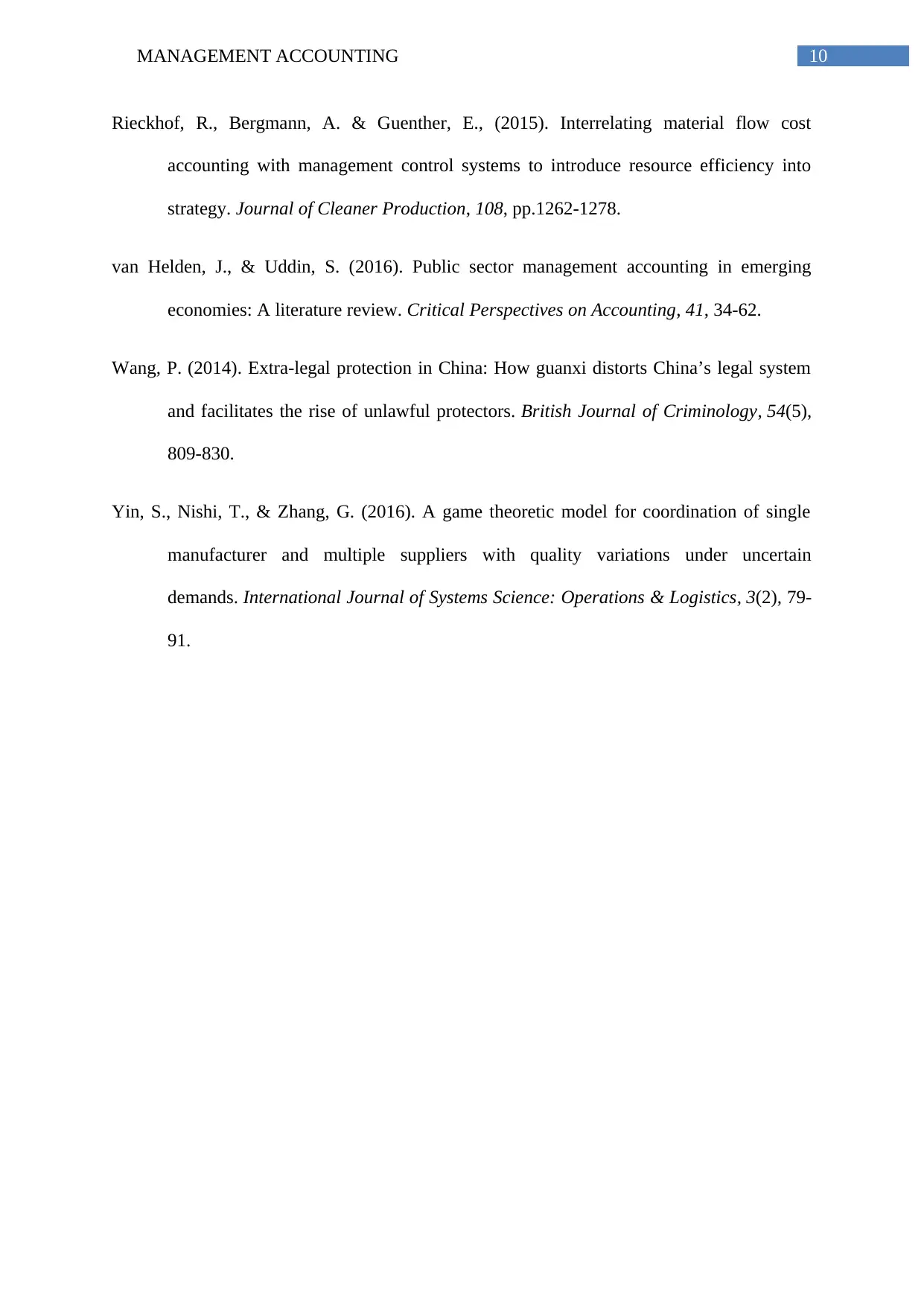
10MANAGEMENT ACCOUNTING
Rieckhof, R., Bergmann, A. & Guenther, E., (2015). Interrelating material flow cost
accounting with management control systems to introduce resource efficiency into
strategy. Journal of Cleaner Production, 108, pp.1262-1278.
van Helden, J., & Uddin, S. (2016). Public sector management accounting in emerging
economies: A literature review. Critical Perspectives on Accounting, 41, 34-62.
Wang, P. (2014). Extra-legal protection in China: How guanxi distorts China’s legal system
and facilitates the rise of unlawful protectors. British Journal of Criminology, 54(5),
809-830.
Yin, S., Nishi, T., & Zhang, G. (2016). A game theoretic model for coordination of single
manufacturer and multiple suppliers with quality variations under uncertain
demands. International Journal of Systems Science: Operations & Logistics, 3(2), 79-
91.
Rieckhof, R., Bergmann, A. & Guenther, E., (2015). Interrelating material flow cost
accounting with management control systems to introduce resource efficiency into
strategy. Journal of Cleaner Production, 108, pp.1262-1278.
van Helden, J., & Uddin, S. (2016). Public sector management accounting in emerging
economies: A literature review. Critical Perspectives on Accounting, 41, 34-62.
Wang, P. (2014). Extra-legal protection in China: How guanxi distorts China’s legal system
and facilitates the rise of unlawful protectors. British Journal of Criminology, 54(5),
809-830.
Yin, S., Nishi, T., & Zhang, G. (2016). A game theoretic model for coordination of single
manufacturer and multiple suppliers with quality variations under uncertain
demands. International Journal of Systems Science: Operations & Logistics, 3(2), 79-
91.
1 out of 11
Related Documents
Your All-in-One AI-Powered Toolkit for Academic Success.
+13062052269
info@desklib.com
Available 24*7 on WhatsApp / Email
![[object Object]](/_next/static/media/star-bottom.7253800d.svg)
Unlock your academic potential
Copyright © 2020–2025 A2Z Services. All Rights Reserved. Developed and managed by ZUCOL.





